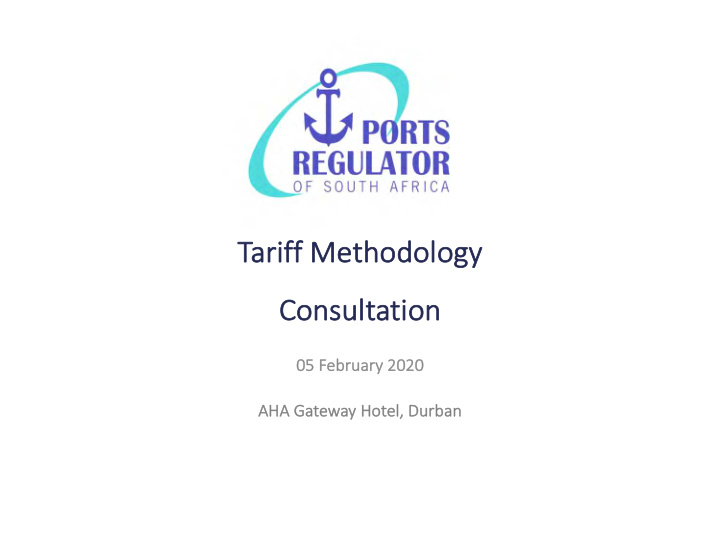



Ta Tariff Methodology Co Consultation 05 05 February 2020 2020 AHA AHA Gateway Hot Hotel el, Durban
Ta Tariff Methodology RR = (RAB*WACC) + Opex + Dep + Tax ± Clawback ± ETIMC ± WEGO • It requires that the NPA estimate its operating costs, depreciation, • tax expense and return on capital (a product of the Weighted Average Cost of Capital and the value of assets in the Regulatory Asset Base for the period under review). In addition, there is a claw-back mechanism that corrects for over • or under recoveries in previous tariff periods, as well as the Excessive Tariff Increase Margin Credit (ETIMC). Efficiency variable introduced • www.portsregulator.org 2
Di Differ eren ences es from om previou ous Tariff Method odol olog ogy • Weighted Efficiency Gains in Operations (WEGO) • Beta • Equitable Tax Rate • Valuation of Assets www.portsregulator.org 3
WE WEGO WE WEGOt GOt = = EGt Gt-1 x x 0.075 x x Ret-1 • Efficiency gains and reductions in individual KPI’s per port will be capped for calculation purposes at 15% • A declining or negative value of EGt-1 will result in an increased claw back over period t . www.portsregulator.org 4
WE WEGO • A higher WEGO weighting from 5% to 7.5% of profit is proposed • A higher efficiency gain is required to achieve a 100% score • WEGO highlights areas where a lack of CAPEX or maintenance is hindering efficiency • WEGO also allows for landside KPIs- Regulator awaits proposals from stakeholders www.portsregulator.org 5
WE WEGO PR PROPOS OPOSED Downti time me Adjustme tment: t: • Downward adjustment of the WEGO • When: downtime in the provision of a service due to factors within the NPA’s control • How: the adjustment will be calculated on the basis of previous revenue streams www.portsregulator.org 6
BE BETA • Beta is required to reflect the risks faced by the NPA under the RR methodology • The claw-back mechanism reduces exposure to systemic risk • Proposal: a β substantially lower than that of large firms listed on the market www.portsregulator.org 7
BE BETA • The consistent returns allowed by the Regulator effectively removes systemic risk This argues for a minimal Beta, the Regulator suggests an asset beta of 0.35 over the period • Results in a lower risk adjusted return www.portsregulator.org 8
Eq Equita table Tax Rate A tax allowance of 28% on NPA profit has been • disproportionately large as compared to the calculated 28% of Transnet net profit, over the period of regulation of the NPA. The continued revenue allowance of 28% of profit for NPA • taxes can only be fair for a stand- alone entity paying its taxes directly to SARS. An equitable tax rate for the fair sharing of the group tax • payable in any year has to be calculated proportionally for all profit-making divisions/segments/business units of Transnet. www.portsregulator.org 9
Eq Equita table Tax Rate • An equitable tax rate averaged over a period 5 years will be used in the RR model • The NPA will be treated as an operating division for tax purposes • The actual equitable rates will be used in the clawback calculation based on audited financial statements www.portsregulator.org 10
Equitable Tax Rate Formula www.portsregulator.org 11
Regu gulator ory A y Asset Ba Base & V & Valuation on of A of Asset VoA published in 2018 & included in draft Methodology in • 2019 Main ideas: • – Financial capital maintenance approach i.e. a ”repayment” of assets as opposed to a “replacement” of assets – – Differentiation between pre and post 1990 assets Pre-1990: HC with straight line depreciation – – Post-1990: TOC with amortization of the trending portion (inflation) over the RUL Asset based RUL as opposed to a 40-year average used previously – www.portsregulator.org 12
Regu gulator ory A y Asset Ba Base & V & Valuation on of A of Assets Full implementation: • will significantly affect the RAB; reduction of R45bn from 18/19 levels – – Sustainability of NPA as standalone subsidiary (Section 3(2) of the Act) was questioned and the Regulator to decided to postpone full implementation pending corporatisation Upon corporatisation, the NPA, if it becomes a borrowing entity, its credit metrics will – have to be considered by the Regulator as part of a tariff methodology to ensure sustainability of a borrowing subsidiary. In this case the Regulator will continue to delay the full implementation of the hybrid approach whilst assessing its impact on the credit metrics. – Non-corporatisation will result in no need for the consideration of credit metrics for the NPA as it remains a non-borrowing division without its own credit rating. www.portsregulator.org 13
Ke ya leboga Ke a leboha Ke a leboga Ngiyabonga Ndiyabulela Ngiyathokoza Ngiyabonga Inkomu Ndi khou livhuha Thank you Dankie Go to http://www.portsregulator.org for documents including Records of Decision, Regulatory Manual, consultation submission and reports and other useful documents www.portsregulator.org 14
Recommend
More recommend